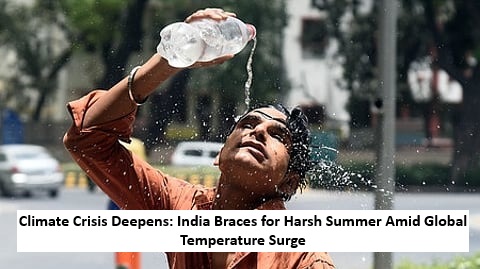
Climate change is no longer a distant threat—it’s a daily reality. According to the Copernicus Climate Change Service (C3S), March 2025 ranked as the second hottest March globally, continuing a troubling trend of rising surface temperatures and extreme weather patterns.
India Faces Early Heatwave Conditions
In India, the India Meteorological Department (IMD) has issued a ‘yellow alert’ for Delhi, where temperatures have already reached 40°C—an unusual spike for early April. This marks only the second time in 15 years that Delhi has seen such high temperatures this early.
A four-day heatwave is now forecast for the national capital, a pattern that did not occur in 2024. West Rajasthan and parts of Gujarat are already facing severe heatwave conditions, while several central states—Madhya Pradesh, Maharashtra, Chhattisgarh, Odisha, Uttar Pradesh, Jharkhand, Telangana, and Karnataka—are recording temperatures 1°C to 4°C above normal.
El Nino’s Role in India’s Rising Heat
Climate experts link the intensifying summer to the El Nino-Southern Oscillation (ENSO) cycle. An El Nino phase, associated with hotter summers and weaker monsoons, has contributed to India’s current heat trends. Even during the weaker La Nina phase that emerged in December, many regions recorded record-high temperatures.
The World Meteorological Organization (WMO) notes that natural climate patterns like El Nino and La Nina are now significantly amplified by human-induced climate change, resulting in more unpredictable and extreme weather across the globe.
Europe and Global Regions Also Break Records
The March 2025 global surface temperature averaged 14.06°C, which is 0.65°C above the 1991–2020 average and 1.60°C above pre-industrial levels. Europe recorded its hottest March on record, accompanied by unusual rainfall levels.
This marks the 20th month in the past 21 where the global temperature exceeded 1.5°C above pre-industrial levels, a critical threshold set by the Paris Agreement.
Above-average temperatures were reported across the Arctic, Canada, parts of the U.S., Mexico, Asia, and Australia, confirming a planet-wide warming trend.
Oceans and Ice Caps Reflect Climate Stress
Rising temperatures are clearly visible in Earth’s oceans and ice systems. The average sea surface temperature (SST) for March 2025 across the 60°S–60°N belt hit 20.96°C, the second highest on record.
Arctic sea ice extent dropped to 6% below average, hitting the lowest March level in 47 years of satellite monitoring. Antarctic sea ice also recorded its fourth lowest extent for March—24% below average.
These ongoing reductions in ice cover signal destabilizing changes in the polar regions, which are warming faster than other areas on Earth.
ENSO Neutral Predicted as Climate Extremes Persist
The Climate Prediction Center forecasts a neutral ENSO phase between April and August 2025, extending through the Northern Hemisphere summer. Despite this moderation, the broader trend of warming is expected to persist due to human-driven climate influences.
As extreme heat events, shifting rainfall patterns, and erratic monsoons become more frequent, India and other vulnerable regions must prepare for continued climate stress in the months ahead.

 Share
Share



